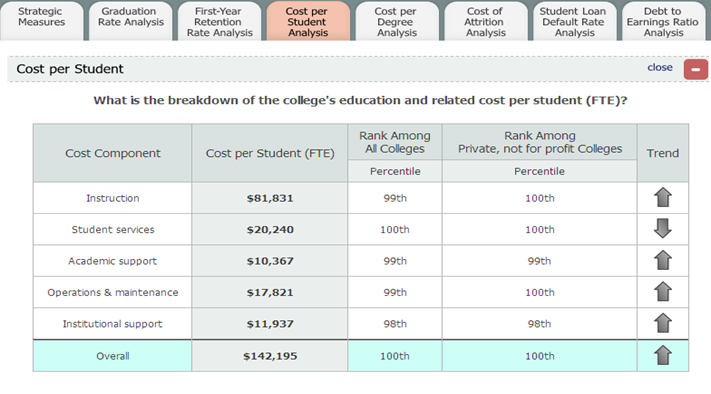CollegeMeasure.org Effectiveness @ 1,500+ colleges
Compares Colleges across Specific Criteria
Yale’s Cost per Student information
Trying to figure out where you might get the best postsecondary value for your educational dollar just became easier. On October 7th, 2010, the website CollegeMeasure.org went live. It’s a free, publicly available, not-for-profit site that has no advertising clutter or strange distractions: just cold hard numbers to compare which colleges do a good job at delivering value for the educational dollar, and which don’t. The organizations behind the site are the Matrix Knowledge Group (an international consulting company) and the American Institute of Research (which specializes in educational research) who both share grave concerns about the American college system which, currently, graduates less than 60% of its students in 6-years, who are attempting to gain degrees from 4-year colleges.
A key question: what do you measure to determine effectiveness and value?
Graduation Rate (graduating in 6 years)
Retention Rate (% of freshmen returning for sophomore year)
Cost per Student (total direct educational costs/# of FTE students)
Cost per Degree (all direct educational spending to acquire degrees/# of degrees awarded in the same year)
Cost of Attrition (costs spent on 1st year students who don’t return for a second year)
Student Loan Default Rate (% of students who default within one year of when loans come due)
Ratio: Student Loan Payments: Earnings of Graduates (annual loan payment/median annual starting pay of graduates)
As you review the seven categories above, you’ll note that each measures 4 goals that any effective postsecondary institution should have: Completion and Progression include #1 & 2; Efficiency, #3; Productivity, #4 & 5; and Gainful employment, #6 & 7.
You can, of course, find a lot of this information at College Navigator. Putting a number on the Cost per Student, Degree, and Attrition, however, can only be found at College Measure.
There are many ways to look at the information. One is to take a category: Cost per Student and see across the 1500+ college universe which colleges invest the most in the direct education of its students. Once you click to the chart (and navigation is very easy and straightforward on www.collegemeasure.org), you will discover that the college spending far and away the most per student on an annual basis is Yale University, at $142,195. The screen shot below clearly tells how the $142,195 is divided: ‘Instruction’ (Yale’s professors are some of the best compensated professors in the country), ‘Student Services’, ‘Academic Support’, Operation and Maintenance’ (Yale has a huge physical plant to maintain-most of the buildings were built during the depression and require substantial maintenance-further Yale is building two new colleges, recently purchased land from a pharmaceutical company to literally double its campus size, and is about to launch an Asian campus in Singapore-a joint venture with National University of Singapore. Some of these efforts are not reflected in the Cost per Student number, but a good portion are), and ‘Institutional Support’.
There is a glossary supplied on the site that clearly explains what each category measures.
What’s interesting about Yale’s $142,000 cost per full-time (FTE) student is that Yale’s tuition is just under $40,000. In essence, through its endowment, Yale is subsidizing each student attending to the tune of about $100,000 per year. Additionally, if a student’s HH Income is less than $200,000, the family pays only 10% of its income towards tuition, a discount of $20,000 off the sticker price. Based on this information, along with this information, it’s not surprising so many students are banging down the door to get in.
Obviously, the very selective schools have an appeal and value all their own. There are a lot of schools you might want to evaluate using this tool. You need to be a discerning customer. The costs of not doing your homework are just too high.


